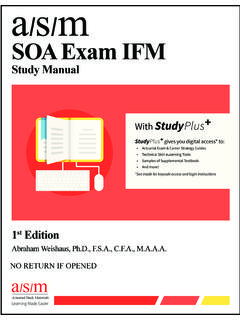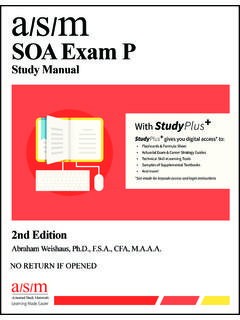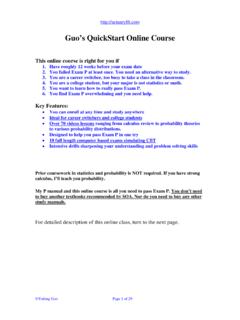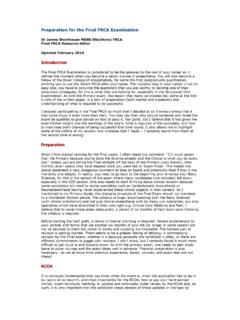Transcription of Actuarial Models : Financial Economics
1 `. Actuarial Models : Financial Economics An Introductory Guide for Actuaries and other Business Professionals First Edition BPP Professional Education Phoenix, AZ. Copyright 2010 by BPP Professional Education, Inc. All rights reserved. No portion of this book may be reproduced in any form or by any means without the prior written permission of the copyright owner. Requests for permission should be addressed to: BPP Professional Education 4025 S. Riverpoint Parkway Phoenix AZ 85040. Mail Stop: CF-K909. Manufactured in the United States of America 10 9 8 7 6 5 4 3 2 1. First Printing ISBN: 0-9753136-1-4. Preface Welcome to this introductory guide to options. Based on our experience as professional educators, our aim when writing this text has been to produce a clear, practical and student-friendly guide in which theoretical derivations have been balanced with a helpful, structured approach to the material.
2 We have supplemented the explanations with over 200 worked examples and practice questions to give students ample opportunity to see how the theory is applied. The result we hope is a thorough but accessible introduction to options. This text has been written for Actuarial students who are preparing for the Financial Economics segment of Exam M of the Society of Actuaries and the Canadian Institute of Actuaries, and Exam 3F of the Casualty Actuarial Society. The Practice Questions at the end of each chapter are designed to emphasize first principles and basic calculation, whereas exam questions can be more difficult. For exam preparation, this text should be used in conjunction with the BPP Q&A Bank, which contains exam-style questions.
3 This text could not have been completed without the contributions of several outstanding individuals. The main text and Practice Questions were compiled and reviewed by David Hopkins and Mike Lewry. Any errors that remain are solely our own. We hope that you find this text helpful in your studies, wherever these may lead you. October 2010. i ii Table of contents Introduction Chapter 0 Introduction to options 1. Introduction 2. Basic notation 2. Call and put options 3. The underlying asset 6. Forward prices 8. Uses of options 11. Chapter 0 practice questions 12. Chapter 1 Put-call parity and other relationships 15. Introduction 16. Arbitrage 16. Notation 17. Put-call parity 17. Duality of prices of foreign currency options 22.
4 Upper and lower bounds for option prices 24. American options and early exercise 27. Effect of the time to expiration on option prices 30. Effect of the strike price on option prices 31. Chapter 1 practice questions 38. Chapter 2 The one-step binomial model 41. Introduction 42. One-step binomial model 42. Expected returns and risk-neutral probabilities 47. Jensen's inequality 51. Identifying arbitrage opportunities 52. Using binomial trees with other types of underlying assets 53. Chapter 2 practice questions 56. Chapter 3 Multi-step binomial trees 59. Introduction 60. Two or more binomial periods 60. Constructing a multi-step binomial tree 61. American options and early exercise 65.
5 Alternative Models 68. Replication using a multi-step binomial tree 70. Estimating the Greeks using a binomial tree 71. Is the binomial model realistic? 73. Chapter 3 practice questions 74. iii Chapter 4 The Black-Scholes formula 75. Introduction 76. The Black-Scholes pricing formula 76. Applying the Black-Scholes formula to other assets 80. Option Greeks 81. Trading strategies 88. Volatility 88. Chapter 4 practice questions 91. Chapter 5 Hedging 93. Introduction 94. Market-making 94. Delta-hedging 94. The delta-gamma-theta approximation 98. The Black-Scholes partial differential equation 102. Chapter 5 practice questions 106. Chapter 6 Exotic options 109. Introduction 110. Asian options 110.
6 Barrier options 115. Compound options 117. Gap options 120. All-or-nothing options 122. Exchange options 123. Chapter 6 practice questions 126. Chapter 7 Brownian motion and It 's lemma 129. Introduction 130. Brownian motion 130. Diffusion processes and stochastic differential equations 135. Common diffusion Models 137. It 's lemma 140. The Sharpe ratio 145. Geometric Brownian motion and Black-Scholes 148. Power options 149. Quadratic variation and total variation 154. Chapter 7 practice questions 156. Chapter 8 Interest rate Models 159. Introduction 160. Modeling bond prices and interest rates 160. Equilibrium short-rate bond price Models 166. The Vasicek model and bond prices 170.
7 Bond options, caps and the Black model 174. A binomial interest rate model 177. The Black-Derman-Toy model 179. Chapter 8 practice questions 187. iv Chapter 9 Monte Carlo methods 189. Introduction 190. Summary of simulation methods 191. Pseudorandom numbers (uniform distribution) 191. Inversion method 193. Standard normal distribution 196. General normal distribution 198. Lognormal distribution 199. Bootstrap method 202. Correlated normals 204. Efficiency and accuracy of Monte Carlo methods 205. Chapter 9 practice questions 208. Answers to practice questions 211. Further reading 215. Index 217. v vi Introduction Before we start the main subject matter in this text, we should take care of a little housekeeping.
8 Assumed knowledge We assume that the reader has knowledge of calculus, probability theory, and interest theory. Ideally, your familiarity with these topics should be at a level sufficient for success with Exams P. (probability theory) and FM ( Financial mathematics) of the SOA (or their equivalent). The necessary background information can be found in BPP textbooks written for these two examinations. You can visit our website and download a free sample chapter from these texts or order a copy. Notation and rounding We have tried hard to ensure that all new notation is explained clearly. We sometimes use exp( x ) in place of e x , especially when this avoids complicated superscripts that might otherwise be difficult to read.
9 Rounding poses a particular dilemma. Our standard policy in this text has been to keep full accuracy within intermediate calculations even though an intermediate result may be shown as a rounded value. So, you may occasionally disagree with the last significant figure or two in a calculation if you calculate the result using the rounded values shown. Worked examples and practice questions Each worked example within the main text is presented in the form of a question that is immediately followed by the solution. You may wish to think about the questions before reading the solutions. The end of each solution is marked with the symbol to indicate where the main text continues. At the end of each chapter we have included some additional practice questions.
10 Short numerical answers to these questions can be found at the end of the book. Detailed worked solutions to these questions can be downloaded free of charge from the BPP Professional Education website at Other useful study resources can also be found there. Errors in this text If you find an error in this text, we'll be pleased to hear from you so that we can publish an errata list for students on our website and correct these errors in the next edition. Please email details of any errors to A current errata list is maintained in the Student Mailbag on the Exam MFE page of the BPP website. Thank you. vii Introduction to options Overview In this chapter we will study the basic types of options.













